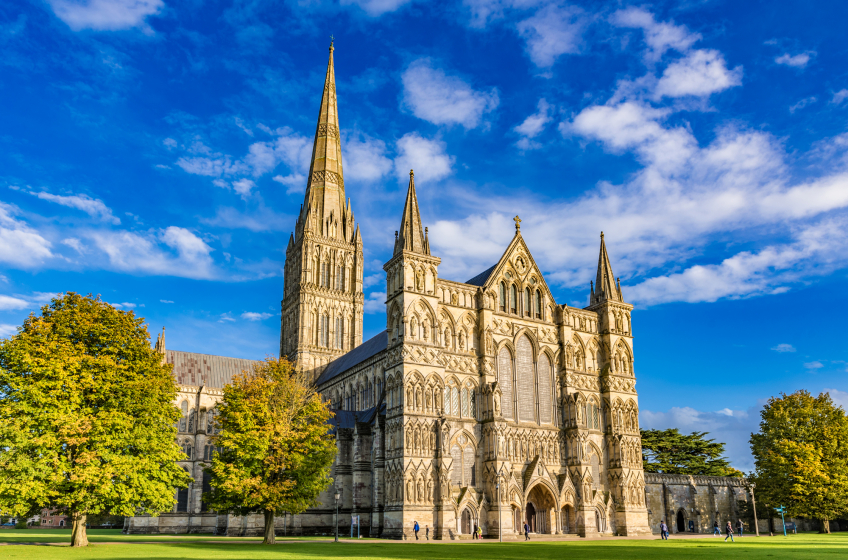Discover Salisbury Cathedral | A Visitor's Introduction to Salisbury Cathedral
Salisbury Cathedral is an iconic example of Early English Gothic architecture. It was constructed between 1220 and 1258, with its distinctive spire being added later in the 14th century. The cathedral is renowned for its historical significance, architectural beauty, and housing one of the original copies of the Magna Carta.
Salisbury Cathedral visitor information
Architectural Features
Salisbury Cathedral boasts the tallest church spire in the United Kingdom, reaching a height of 404 feet (123 meters). The structure is predominantly constructed from Chilmark stone, and its interior features Purbeck marble, adding to its aesthetic appeal. The cathedral’s layout follows a traditional cruciform plan, comprising a long nave, transepts, and a choir. The cloisters and chapter house, added in the early 14th century, are noteworthy for their intricate details and design.
The cathedral's nave is the longest in England, measuring 248 feet (75 meters). The West Front is adorned with over 130 sculptures, many of which date back to the original construction period. The stained glass windows, particularly those in the Trinity Chapel, depict biblical stories and saints, adding a vibrant touch to the interior.
The Magna Carta and Medieval Clock
One of the most significant attractions within Salisbury Cathedral is the presence of one of the four surviving original copies of the Magna Carta, dating back to 1215. The document is displayed in the Chapter House, which features an octagonal shape and intricate medieval friezes. Visitors can learn about the Magna Carta's history and its impact on constitutional law through informative displays.
Additionally, the cathedral houses one of the oldest working clocks in the world, dating back to 1386. This medieval clock, which originally regulated the timing of services, is a fascinating piece of engineering history. It has no face and strikes the hour on a bell. Located in the North Nave Aisle, the clock is a testament to the ingenuity of medieval craftsmen
Visiting Information
Opening Hours: The cathedral is open to visitors from Monday to Saturday, 9:00 AM to 5:00 PM, and on Sundays from 12:00 PM to 4:00 PM. These hours can vary, so it’s advisable to check the cathedral’s official website before planning your visit.
Admission Fees: While entry to the cathedral is free, donations are encouraged to help with the upkeep and preservation of the building. Guided tours are available for a fee, offering a more in-depth exploration of the cathedral's history and architecture.
Tower Tours: For those interested in panoramic views, the cathedral offers tower tours that allow visitors to climb the 332 steps to the base of the spire. These tours provide a unique perspective of the cathedral and the surrounding Wiltshire countryside. Due to the physical exertion required, tower tours may not be suitable for all visitors.
Facilities: The cathedral is equipped with various visitor facilities, including a café, gift shop, and restrooms. The café serves a range of refreshments and meals, using locally sourced ingredients. The gift shop offers a variety of souvenirs, books, and locally crafted items.
Accessibility: Salisbury Cathedral is committed to accessibility, providing ramps, lifts, and accessible restrooms to ensure that all visitors can enjoy the site. Wheelchair users can navigate most areas of the cathedral, though some parts of the tower tours may be inaccessible.
Practical Tips
Dress Appropriately: Given the cathedral’s religious significance, visitors are encouraged to dress respectfully.
Photography: Non-flash photography is permitted in most areas, but visitors should be mindful of others and avoid disrupting services or tours.
Plan Ahead: To make the most of your visit, consider checking the schedule for special events, services, or concerts that might be taking place during your visit.
Parking: Limited parking is available near the cathedral, with additional parking options in the city centre.
Shortlist
- Your Shortlist is empty

